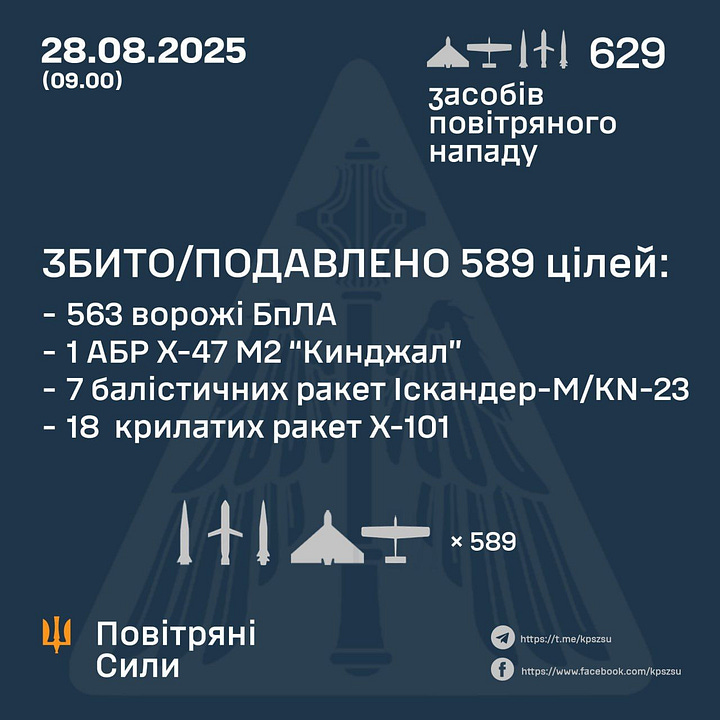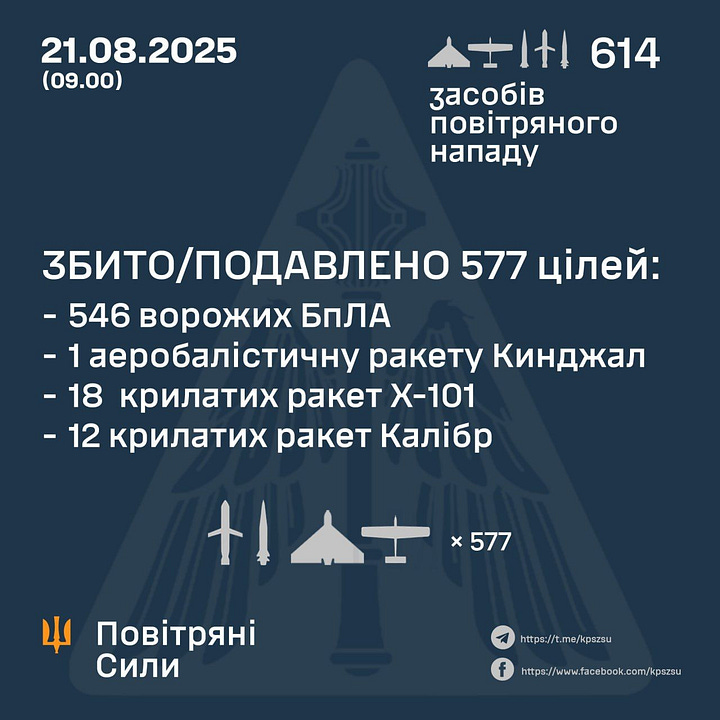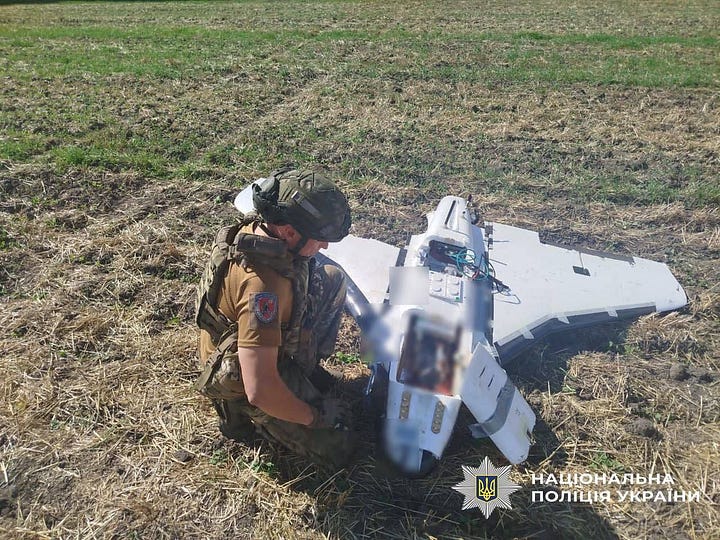New Ukrainian Air Force Disclosure Offers Insight Into Scale Of Russian Decoy Drone Employment
🇷🇺 🇺🇦
Note: The following text was originally posted on my X/Twitter account.
While the Ukrainian Air Force's daily disclosures of the number of Russian strike munition launches and the number of (claimed) Ukrainian interceptions thereof are very useful for observers of the Russia-Ukraine War, it is important to recognize that these figures do not disaggregate the launches and claimed interception of (seemingly) primarily unarmed decoy drones, such as the Russian Gerbera, from the likes of Shahed-136/Geran-2/Garpiya strike drones. Starting around the autumn of 2024, Russia has been employing decoy drones such as the Gebera with increasing regularity and in ever-increasing numbers. It is important to note that the Gebera can, at most, only be equipped with a very small and rather token 1-3 kilogram-class warhead—Russia's Shahed-136/Geran-2/Garpiya strike drones are regularly equipped with either 50-kilogram or 90-kilogram class warheads. We are, as such, dealing with very different types of uncrewed fixed-wing aircraft. While Ukrainian officials have, over time, offered figures for the number of decoy drones that Russia has used and the percentage of "Shahed type strike drones and various types of imitator/simulator drones" that are, infact, (seemingly) primarily unarmed decoy drones, we can now use the Ukrainian Air Force's own disclosures to discern that some 32% of the claimed "Shahed type drones" that Ukraine claims to have intercepted over the course of August 2025—and an unknown percentage of claimed launches thereof—appear to have been interceptions of Russian decoy drones such as the Gerbera, not Shahed-136/Geran-2/Garpiya strike drones that typically carry significantly larger and far more consequential/non-token warheads.




If you compile the Ukrainian Air Force's daily press releases made over the course of August 2025—which are the figures that are (often uncritically) repeated by journalists, commentators, analysts, and politicans worldwide—Russia is said to have launched a total of 4120 "strike drones of the Shahed type and various types of drone simulators"—i.e., decoy drones—of which 3436—some 83.4%—are said to have been successfuly intercepted or neutralized through electronic warfare by the Ukrainian military. These figures do not, of course, disaggregate (seemingly) primarily unarmed decoy drones from armed Shahed-136/Geran-2/Garpiya strike drones.
At the start of September 2025, the Ukrainian Air Force released a monthly summary of its accomplishments in the areas of air defence and ballistic missile defence for August 2025. According to this monthly summary, the Ukrainian Air Force claims that Ukraine only intercepted 2129 Shahed-136/Geran-2/Garpiya strike drones, which is to say that most—if not all—of the 1307 other intercepted drones—some 31.72%—were (seemingly) primarily unarmed decoy drones such as the Gerbera.
While the Ukrainian Air Force's longstanding practice of issuing daily press releases necessarily entails compromised data collection efforts—it takes time to investigate all interception claims, debris, and so forth—the monthly summary for August 2025 indicates that the Ukrainian Air Force can, with time, disaggregate the number of (seemingly) primarily unarmed decoy drones that it intercepts from the number of armed strike drones that it intercepts. Stated differently, journalists, commentators, analysts, and politicians are best off waiting for better/more refined data and are well advised to consume the Ukrainian Air Force's daily press releases with a lot of caution. While "Russia launches 600 drones against Ukraine today" is a great headline, we appear to be dealing with a situation in which some 200/600 of said "drones" are likely to be (seemingly) primarily unarmed decoy drones such as the Gerbera.
Serious analysis of the implications of the Russia-Ukraine War for other countries requires better data, a more discerning eye and greater circumspection toward decidedly non-neutral and selectively disclosed available data, and sound analytical frameworks more generally. Simply stated, many of the claimed "lessons" of this war are unlikely to be generalizable to other countries and contexts. Much has been made of Ukraine's apparent and claimed success in largely neutralizing the Russian propeller-driven strike drone threat. If we take the Ukrainian Air Force's daily press releases at face value, Ukraine successfully intercepted or neutralized through electronic warfare some 83.40% of Russian strike drones *and* decoy drones over the course of August 2025. When it comes to the use of electronic warfare to neutralize Russian strike drones and/or decoy drones, it is important to recognize that there is a lot of variance in the types of Global Navigation Satellite System (GNSS)—GPS and its non-American analogues—antenna arrays installed on not just Russia's strike drones but also its decoy drones.
It is possible, even likely (given available images and videos of debris and downed/crashed specimens), that most of Russia's Gerbera decoy drones are equipped with less expensive and more readily available GNSS antenna arrays that are less resilient to the effects of Ukrainian electronic warfare systems (i.e., GNSS jamming and spoofing). There are many ways to employ aerial decoys, and not all approaches require the decoy drone to accurately fly along a specific preprogrammed flight path. In some cases, it may suffice to simply occupy enemy air defences and present an additional target on the enemy's sensor displays. For some roles, however, Russia needs a Gerbera decoy drone to not only penetrate Ukrainian airspace but also accurately navigate toward a distant target. Russia may, for example, want to have several Gerbera decoy drones to occupy Ukrainian air defences around Kyiv, a sector that is likely to not only be home to a high concentration of air defence systems but also a high concentration of electronic warfare systems. As a result, some—but not all—Gerbera decoy drones require a higher-end GNSS antenna array.
We also need to consider the possibility that Ukrainian air defences may decide not the intercept a positively identified Gerbera decoy drone or at least not prioritize its interception, a dynamic which will also affect the interception rate. With most Gerbera decoy drones (seemingly) being employed in an unarmed state, these decoy drones, which are made of foam and plywood, will eventually run out of fuel and crash into the ground as a functionally inert projectile that will neither detonate upon impact nor combust. While it is possible to characterize such Gerbera drones as specimens which "fail" their assigned mission, it is also possible to view such Gerbera drones as low-cost decoy drones that fulfilled their intended purpose. In other words, observers may be misinterpreting the significance of the Ukrainian Air Force's claimed interception and neutralization figures even if these figures are, in fact, accurate, albeit not disaggregated. It is worth noting that unfolding measure-countermeasure dynamics incentivize Russia to arm its Gebera decoy drones whenever possible—which is to say whenever it is possible to trade range for greater payload in a given mission—so that Ukrainian air defences are induced to undertake interception attempts.

